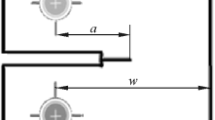Abstract
From the stress intensity factors induced by a circular loop attached to a crack front, the resulting image force acting on the dislocation was calculated. The relaxation of the elastic energy stored due to neighbouring surfaces is obtained through integration of the variation of the image force while shifting the loop towards the inside of the material. The amount of relaxation, as numerically determined in this paper under a given loading, is too small to sufficiently decrease the energy barrier for triggering of dislocation emission. Homogeneous nucleation on a perfect crack front is impossible. Since dislocation emission has been experimentally observed under the loading considered, it must come from defects along the crack front.
Similar content being viewed by others
References
A George G. Michot (1993) ArticleTitleDislocation loops at crack tips: nucleation and growth – an experimental study Mater Sci Eng A 164 118–134 Occurrence Handle10.1016/0921-5093(93)90649-Y
Hirth JP, Lothe J (1968) In J.P. Hirthe and J. Lothe (eds) Theory of dislocations. McGraw-Hill Book Company, New-York, pp.144
Hirth JP, Lothe J (1968) In: J.P. Hirthe and J. Lothe (eds) Theory of dislocations. McGraw-Hill Book Company, New-York, pp 105
MA Loyolade Oliveira G. Michot (1998) ArticleTitleThree dimensional analysis of the interaction between a crack and a dislocation loop Acta mater 46 1371–1383 Occurrence Handle10.1016/S1359-6454(97)89507-9
JR Rice R Thomson (1974) ArticleTitleDuctile versus brittle behaviour of crystals Philos Mag 29 73–96
JR. Rice (1992) ArticleTitleDislocation nucleation from a crack tip: an analysis based on the Peierls concept J Mech Phys Solids 40 239–271 Occurrence Handle10.1016/S0022-5096(05)80012-2
C Scandian H Azzouzi N Maloufi G Michot A. George (1999) ArticleTitleDislocation nucleation and multiplication at crack tips in silicon Phys Stat Sol (a) 171 67–82 Occurrence Handle10.1002/(SICI)1521-396X(199901)171:1<67::AID-PSSA67>3.0.CO;2-T Occurrence Handle1999PSSAR.171...67S
Sih GC, Lieboewitz H. (1968) In: H. Lieboewitz (ed) Mathematical theories of brittle fracture. Fracture II. Academic Press, New York, 2, pp 67
G Xu AS Argon M. Ortiz (1997) ArticleTitleCritical configuration for dislocation nucleation from crack tips Philos Mag. A 75 341–367
Author information
Authors and Affiliations
Corresponding author
Rights and permissions
About this article
Cite this article
Michot, G., Gonzalez, B.M. Is a crack an effective stress riser for triggering of plasticity?. Int J Fract 139, 359–367 (2006). https://doi.org/10.1007/s10704-006-0056-9
Received:
Accepted:
Issue Date:
DOI: https://doi.org/10.1007/s10704-006-0056-9




